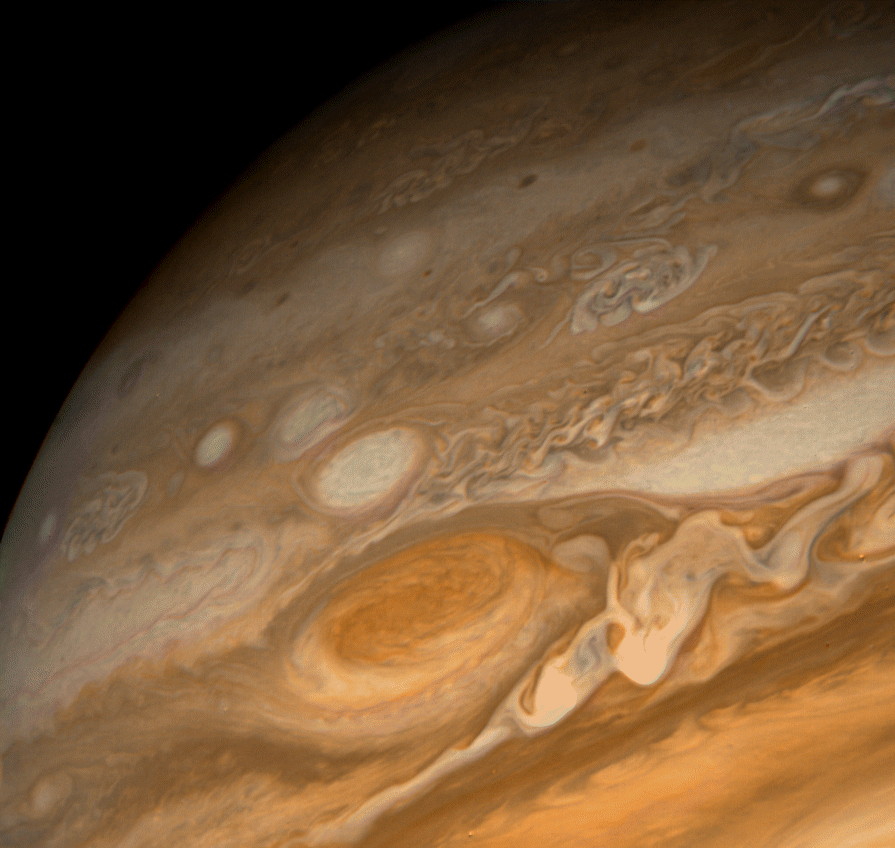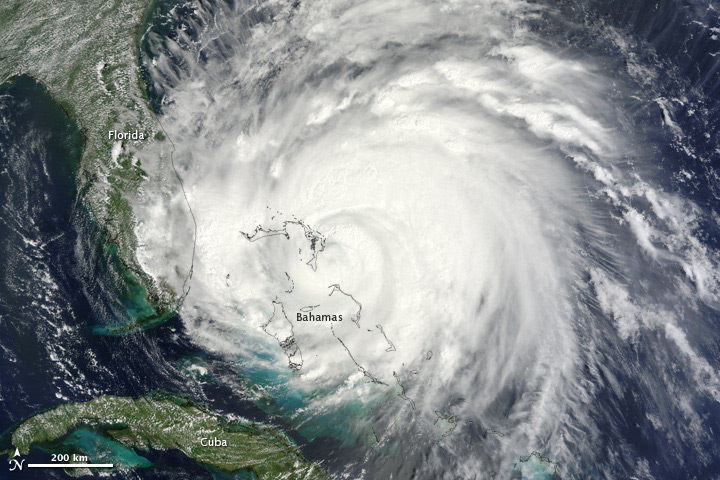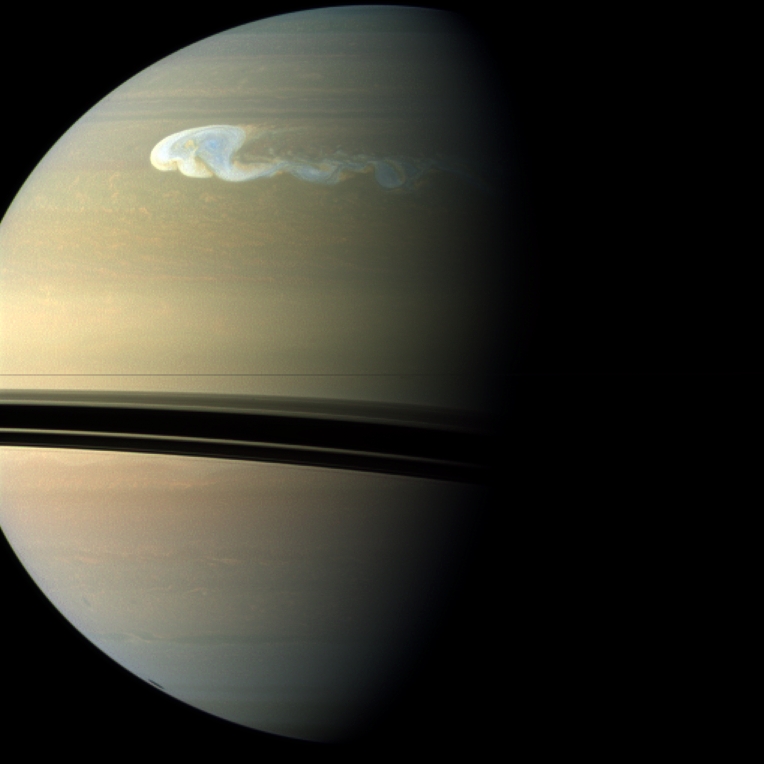Extraterrestrial Hurricanes: Other Planets Have Huge Storms, Too

By Earth standards, Hurricane Irene is a monster storm. But it's just a baby compared to the massive cyclones of Jupiter and Saturn.
Our planet is not the only one in the solar system that boasts huge, hurricane-like storms. The gas giants Jupiter and Saturn, for example, churn out spinning squalls that can be bigger than the entire Earth. While these storms aren't fed by warm ocean water the way terrestrial hurricanes are, they're similar in a lot of ways, scientists say.
"There certainly are storms that have thunder and lightning and rain that are bigger than terrestrial hurricanes," said atmospheric scientist Andrew Ingersoll of the California Institute of Technology, a researcher with NASA's Cassini mission to Saturn. "And more violent — the winds on those planets are stronger, too." [Photos: Most Powerful Storms of the Solar System]
Giant planets, giant storms
Hurricane Irene measured about 600 miles (966 kilometers) across as it bore down on the U.S. East Coast today (Aug. 26).
That's big and scary, but it pales next to storms on our solar system's gas giants. Jupiter's Great Red Spot — which has been raging continuously for at least 180 years — could fit two entire Earths within it, Ingersoll said.
And in December, a thunderstorm about 6,200 miles (10,000 km) wide erupted on Saturn. This one, known as the Great White Spot, is still going strong, and some of its clouds have wrapped all the way around the ringed planet. [Top 10 Extreme Planet Facts]
Breaking space news, the latest updates on rocket launches, skywatching events and more!
The Great White Spot also generates lots of lightning, just like thunderstorms here on Earth.
"We can see the lightning flashes on the night side, and we can hear the radio static from the lightning," Ingersoll told SPACE.com. "The energy in the lightning flashes is a lot stronger than terrestrial lightning."
Further, last year, astronomers spotted a cyclone at Neptune's south pole that was thousands of miles wide. The Neptune squall was similar to a spinning storm discovered a few years earlier at Saturn's south pole, which even had a well-developed eye, just like an Earth hurricane.
But the Saturn polar vortex was much bigger than any hurricane found on Earth. Its eye alone measured about 2,500 miles (4,000 km) in diameter; the eye of a typical terrestrial hurricane may be just 2 or 3 miles across.
Energy and moisture
Here on Earth, hurricanes gain their power from warm ocean water.
Warm, moist air over tropical or subtropical seas rises, causing a zone of lower air pressure beneath it. Higher-pressure air zips in to fill the void. But that air soon warms, becomes moist and rises, too. As this pattern repeats, a huge, swirling storm is born.
Jupiter and Saturn don't have oceans, so their spinning storms aren't "hurricanes" in the strict, terrestrial sense. But similar processes spawn them, according to Ingersoll. [Photos: Jupiter, Largest Planet in the Solar System]
"Heat makes buoyancy; hot air rises," Ingersoll said. "Heat also causes evaporation of moisture, and when the moisture condenses and forms rain, that releases the energy. So, energy and moisture."
Most of the energy driving Earth's hurricanes ultimately comes from the sun. But that may not be the case on Jupiter and Saturn, which orbit our star from much farther away than Earth does.
"They're so giant that they still have retained some of their heat of formation," Ingersoll said. "So they have their own internal heat that can generate these giant storms."
The moisture requirement explains why gigantic, hurricane-like storms don't seem to occur on Venus or Mars, he added.
"The giant planets have moisture down below the clouds," Ingersoll said. "But Venus doesn't. Venus is dry as a bone, hot and dry. It's not comparable. And Mars is cold and dry."
Saturn storm mysteries
Saturn's Great White Spot tends to erupt every few decades, shattering long periods of calm and quiescence. Scientists still aren't sure why some storms on the giant planets should be so big, and so infrequent.
"For some reason, they store up that energy for a long time, then let it loose in a violent, huge storm," Ingersoll said. "It didn't have to work out that way; they could let off a little popcorn now and then. But they don't do that."
He's hoping that Cassini will help resolve this question — just one of many that scientists are grappling with as they try to understand the weather systems on other planets.
"We're working right now on this giant Saturn storm, with that exact question in mind," Ingersoll said.
You can follow SPACE.com senior writer Mike Wall on Twitter: @michaeldwall. Follow SPACE.com for the latest in space science and exploration news on Twitter @Spacedotcom and on Facebook.

Michael Wall is a Senior Space Writer with Space.com and joined the team in 2010. He primarily covers exoplanets, spaceflight and military space, but has been known to dabble in the space art beat. His book about the search for alien life, "Out There," was published on Nov. 13, 2018. Before becoming a science writer, Michael worked as a herpetologist and wildlife biologist. He has a Ph.D. in evolutionary biology from the University of Sydney, Australia, a bachelor's degree from the University of Arizona, and a graduate certificate in science writing from the University of California, Santa Cruz. To find out what his latest project is, you can follow Michael on Twitter.



